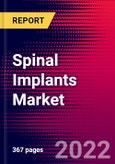Throughout this medical market research, the publisher analyzed 38 spinal implants companies across China and utilized their comprehensive methodology to understand the Market Sizes, Unit Sales, ASPs, Company Market Shares, and to create accurate forecasts.
A major market limiter in the spinal implant and VCF market in China is the introduction of provincial and federal volume-based purchasing (VBP) tenders. The VBP system allows companies to obtain a large quantity of unit sales through a tender system based on unit price and other factors. As a result, the average prices for implants will see a large reduction in 2021. Some market segments will experience a greater VBP effect than others; however, the total market will experience headwinds from the VBP.
One major driver in the Chinese spinal implant and VCF market in 2021 is the growth of a key demographic for spinal fusion. Both fusion and non-fusion procedures are typically performed to treat spinal complications that are much more common in elderly patients. In China, approximately 17.4% of the population was over 60 years of age in 2020, and this is expected to grow to 24.8% by 2030. The growth of this population is expected to stimulate growth in both fusion and non-fusion spinal implant markets.
An emerging trend in the Chinese spinal implant and VCF market is national policies that favor domestic manufacturer and companies. As China continues to implement national policies to lower medical costs, the introduction of import taxes on international medical consumables will create an environment where international competitors not producing within China bear a substantial increase in import costs. The introduction of the two-invoice system on medical consumables, which will lower cost for hospitals by removing the intermediary distributers, will also negatively affect international competitors who offer a wide portfolio of products, as distribution will have to become internalized within the manufacturing company.
Overall, the Chinese spinal implant and VCF market was valued at approximately $2.5 billion in 2021. This is expected to increase over the forecast period at a CAGR of 9.7% to reach $4.7 billion.
A major market limiter in the spinal implant and VCF market in China is the introduction of provincial and federal volume-based purchasing (VBP) tenders. The VBP system allows companies to obtain a large quantity of unit sales through a tender system based on unit price and other factors. As a result, the average prices for implants will see a large reduction in 2021. Some market segments will experience a greater VBP effect than others; however, the total market will experience headwinds from the VBP.
One major driver in the Chinese spinal implant and VCF market in 2021 is the growth of a key demographic for spinal fusion. Both fusion and non-fusion procedures are typically performed to treat spinal complications that are much more common in elderly patients. In China, approximately 17.4% of the population was over 60 years of age in 2020, and this is expected to grow to 24.8% by 2030. The growth of this population is expected to stimulate growth in both fusion and non-fusion spinal implant markets.
An emerging trend in the Chinese spinal implant and VCF market is national policies that favor domestic manufacturer and companies. As China continues to implement national policies to lower medical costs, the introduction of import taxes on international medical consumables will create an environment where international competitors not producing within China bear a substantial increase in import costs. The introduction of the two-invoice system on medical consumables, which will lower cost for hospitals by removing the intermediary distributers, will also negatively affect international competitors who offer a wide portfolio of products, as distribution will have to become internalized within the manufacturing company.
Overall, the Chinese spinal implant and VCF market was valued at approximately $2.5 billion in 2021. This is expected to increase over the forecast period at a CAGR of 9.7% to reach $4.7 billion.
Table of Contents
EXECUTIVE SUMMARY
RESEARCH METHODOLOGY
IMPACT OF COVID-19 ON THE CHINA SPINAL IMPLANT AND VCF MARKET
DISEASE OVERVIEW
PRODUCT ASSESSMENT
CHINA SPINAL IMPLANT AND VCF MARKET OVERVIEW
PROCEDURE NUMBERS
CERVICAL FIXATION MARKET
THORACOLUMBAR FIXATION MARKET
INTERBODY DEVICE MARKET
MOTION PRESERVATION DEVICE MARKET
VERTEBRAL COMPRESSION FRACTURE MARKET
SPINAL SURGERY INSTRUMENTATION MARKET
APPENDIX: ELECTRICAL STIMULATION MARKET
Companies Mentioned (Partial List)
A selection of companies mentioned in this report includes, but is not limited to:
- AND Science & Technology
- B. Braun
- BMK Medical
- Boss Instruments
- Boston Scientific
- CANWELL Medical
- NuVasive
- Centinel Spine
- Optimed
- Chunlizhengda Medical
- Orthofix
- Cousin Biotech
- Paonan Biotech
- Eaven Medical
- Richard Wolf
- Gemmed Medical
- SIGNUS Medical
- Globus Medical
- Spineart
- IDEAL Medical
- SpineVision
- iMEDICOM
- Spirit Medical
- Innomed
- Surgalign
- IRENE Orthopedic
- Taeyeon Medical
- Jiangsu Jinlu Group
- Teleflex
- JMT
- Ulrich Medical
- Kailitai Medical
- XC Medico Technology








